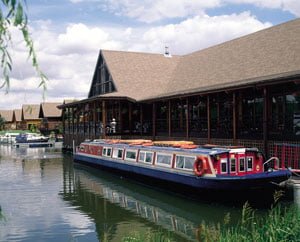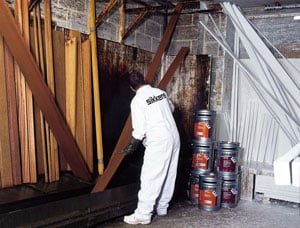
This case study examines how Akzo Nobel is building on the heritage of some of its established coatings for timbers at a time when governments and consumers are increasingly aware of the importance of sustainable production and its effects on the environment.
The second half of the twentieth century was one of unprecedented growth in living standards for many in the Western world. People were able to enjoy a wider range of products offering them technologically advanced solutions to their needs – more comfortable homes, a wider range of easy-to-cook foodstuffs, entertainment at home, and so on.
However, by the closing decades of the century, serious questions were being raised about the road to progress. A number of the solutions being provided by businesses were clearly unsustainable, involving the waste of precious resources and the creation of pollution. Increasingly, governments and consumers were seeing the need to conserve scarce resources and to find more sustainable patterns of growth.
This case study highlights the importance of providing sustainable solutions – showing how Akzo Nobel is providing a sustainable solution through its wood coatings for windows. This is much more in tune with current environmental thinking than PVC-u double-glazed windows which have been so popular in recent decades
Akzo Nobel
Akzo Nobel’s origins date back to the 1770s. It is now a multi-national, multi-product firm and the world’s leading producer of all kinds of coatings, i.e. paints, finishes, stains, printing inks and adhesives.
Based in the Netherlands, Akzo Nobel has developed a diverse product portfolio, from industrial coatings and domestic DIY markets, to highly specialised durable finishes on cars, ships and aircraft. Within the UK, Akzo Nobel is the leading supplier of paints, coatings and associated products.
Akzo Nobel Woodcare is a Division of Akzo Nobel Decorative Coatings and has, since its creation, been responsible for the sales and marketing of coatings for timber under the brand names of Sikkens and Sadolin. The product portfolio consists of high performance professional joinery coating systems and products which are supplied directly to joinery manufacturers or through carefully selected distribution channels.
History
During the 1990s there was increasing governmental and environmental pressure on the UK’s construction companies to address construction procurement methods and efficiency and engage in more sustainable practices. This took place against a background of global concern about causing irreparable damage to the planet’s resource base. The construction industry must think carefully about how and why it uses scarce resources.

In 1998, a Construction Task Force was set up to investigate poor industry standards. The outcome was the publication of the Egan Report which revealed under-achievement within the construction industry, low profitability and insufficient investment in capital, research and development and training. The Report contained proposals for improving construction performance and stated that the industry must design projects for ease of construction and processes with improved energy efficiency.
Sustained improvement should be delivered through use of techniques for eliminating waste and increasing value for the customer. Instead of focusing primarily on the base price of a project, construction firms should take wider consideration of future maintenance costs and environmental impact. For example, it may appear cost effective to install cheap windows but if they need extensive maintenance or replacement after a short period of time then the initial purchase proves to be a false economy.
As a result of the Egan Report, a Local Government Act was passed laying a new statutory duty of best value for local authorities. As well as local authorities and housing associations many private facilities and property managers are also adopting the best value concept.
This was particularly relevant in the case of the replacement window market which was often more concerned with providing PVC-u windows as a short term solution than with any thoughts of long-term performance, maintenance and implications on the environment.
For years, the pressure group Greenpeace has been active in highlighting the environmental concerns with PVC-u and was particularly scathing in its criticisms of the Government demanding that:
‘The UK Government has agreed to eliminate hazardous substances by 2020. Let’s start with PVC-u windows.’
PVC-u stands for unplasticised polyvinyl chloride. (Soft PVC, often called vinyl, contains softeners or plasticisers. PVC-u does not contain these softeners and is hard and inflexible as a result.)
The production and disposal of all types of PVC release some of today’s most damaging industrial pollutants and some of the chemicals used to make PVC-u are the subject of international conventions to ban them.
When PVC-u windows are disposed of, many of these chemicals are again released into the environment, either through chemical reactions caused when PVC-u is incinerated or through depositing old PVC-u frames in landfill sites.
A whole cost approach

In order to ensure its future as a building and design material, it is in Akzo Nobel’s interests as a coatings manufacturer to invest in raising awareness of timber, in particular timber that will require treatment and/or decoration. Positive promotion of timber is required not only within the building and design industry, but also within the minds of the general public.
When compared with commonly used alternatives, including PVC-u, the use of timber is the best solution for sustainability. Well designed timber windows which are coated with high performance coatings in a controlled factory environment before being delivered to site can last much longer than plastic alternative products. You have only to look at Britain’s wealth of historic buildings which have been there for hundreds of years to appreciate the viability of timber.
Taking a whole cost approach as opposed to one based on short term decisions there is no comparison. Timber can and frequently does last for decades and centuries when treated with the right products.
Identifying the challenge

A key business tool for planning an appropriate strategy for an organisation is a SWOT analysis which identifies the internal strengths and weaknesses of a company and/or its products and the external opportunities and threats facing the organisation.
In developing a Joinery Strategy for its Woodcare Division, business planners at Akzo Nobel needed to look carefully at the key elements in the SWOT. One of the Woodcare Division’s weaknesses in the 1990s was its focus. It concentrated on providing traditional solutions to people’s needs for windows and doors in houses – i.e. coatings for timber when many householders were replacing the wooden frames of their parents’ and grandparents’ houses with PVC-u substitutes. Competitors posed a threat by supplying PVC-u solutions to householders through direct selling techniques.
However, by investing in ongoing product development, Akzo Nobel’s Woodcare Division was building on its reputation for launching technologically advanced coating systems and products. This reputation has passed the test of time. Wooden windows and doors are associated with the UK’s history of quality craftsmanship.
However, more and more people began to understand the importance of sustainable business practices. Pressure groups, governments and informed sources within the construction industry began to question practices that were harmful to the environment. This opened a new window of opportunity for sustainable products such as Sikkens and Sadolin.
One of the most powerful arguments in favour of using timber for windows and doors is the environmental one. Timber is a natural product and a truly renewable resource, the production and processing of which when carefully managed can have no negative and many positive effects on our environment.
The strategy

All successful business organisations have a strategy, i.e. a long-term plan which sets out the key objective of the organisation over a period of time (usually about five years).
Akzo Nobel’s key objective is:
‘Through the development of our Joinery brands, establish/extended maintenance programmes based upon the specifications of Sikkens and Sadolin Joinery and Woodcare products, to realise a lifetime strategy for timber.’
Akzo Nobel Woodcare Products division is therefore actively seeking to communicate the importance of changing back to timber and using key products in particular those from the Sikkens range to coat and maintain timber.
This strategy involves:
- establishing a complete range of woodcare products and services that meet the specific needs of its customer base
- communicating valued product qualities and benefits that significantly differentiate its brands from those of its competitors
- gaining acceptance of its products by providing total integrity of the specification of Sikkens woodcare products from inception to completion
- broadening and strengthening its distribution base.
The success of the new strategy depends heavily on effective communication. Akzo Nobel is convinced that it has the right product for a sustainable future. It is therefore utilising all available communication channels to promote Akzo Nobel Woodcare. The emphasis is on promoting timber as a renewable building/design material as well as the commercial and environmental benefits of top quality coating systems. Communications demonstrate how measurable cost savings can be realised through planned maintenance programmes.
Example
Well-designed timber windows that have been factory finished will only require a one coat maintenance every five years compared to standard base stained windows that will require at least two coats together with other remedial works during the maintenance programme. A Housing Association with a medium sized housing site of 45 units could make the savings over a 30 year period. Saving £26,775 on one site on a national basis could equate over 12 sites to £321,300.

Akzo Nobel has identified joinery manufacturers with whom it wishes to develop long term partnerships. In addition, a database of joinery and other relevant manufacturers in existing and new markets has been identified to enable the company to widen its customer base.
In order to pursue this strategy Akzo Nobel is researching best practice in product development programmes in Europe and continuously seeking to improve its product so that it remains the first choice for the construction industry and householders. At the same time it is seeking to tailor its range of products to what customers require.
By feeding the latest research in product technology into its product development Akzo Nobel is able to lead the field and quickly bring innovative products to market.
Communications are designed specifically for relevant groups including:
- architects and specifiers
- local authorities and housing associations
- contractors.
Conclusion

Through maintaining confidence in the heritage of timber and high quality timber coatings, Akzo Nobel has developed a strategy which has turned potential weaknesses into strengths and threats into opportunities.
Today we are seeing a fundamental change in attitudes towards the way in which we value the environment and how we use resources. The quick-fix days of PVC-u windows are hopefully behind us as customers return to the traditional strength of sustainable products.
Government pressure and growing environmental awareness in the construction industry and among householders provide a tremendous opportunity for products like Sikkens and Sadolin. Through industry partnerships, Akzo Nobel is helping to spearhead the resurgence of timber, with an emphasis on sustainability.
